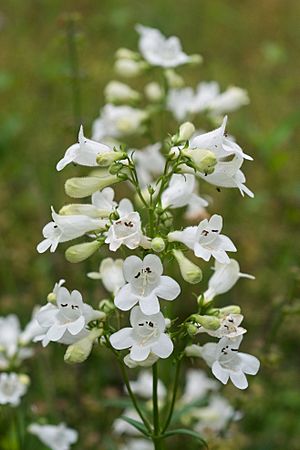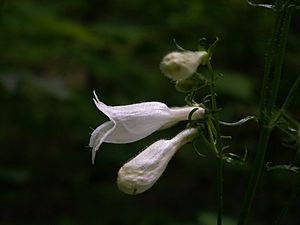Foxglove beard-tongue facts for kids
Quick facts for kids Foxglove beard-tongue |
|
|---|---|
 |
|
| Flowers of P. digitalis | |
| Scientific classification | |
| Genus: |
Penstemon
|
| Species: |
digitalis
|
The Penstemon digitalis is a beautiful flowering plant. You might know it by its common names like foxglove beard-tongue or white beardtongue. This plant belongs to the plantain family, called Plantaginaceae. Its flowers are white and bloom during the summer. You can find this plant growing naturally in eastern Canada and across the eastern and southeastern United States.
About the Foxglove Beardtongue Plant
The Penstemon digitalis is a plant that grows from 3 to 5 feet tall. It's an herbaceous plant, which means it has soft, green stems instead of woody ones. Its stems are slender and often purple. The plant has smooth, shiny green leaves that grow in pairs. These leaves can be up to 5 inches long.
The plant's flowers grow in a special cluster called a panicle. This flower cluster can reach almost one-third of the plant's total height! Each flower has a small stalk, called a pedicel, about a quarter of an inch long. The flowers themselves are about 1.25 inches long. They are shaped like tubes with two lips and have tiny white hairs on the outside. The plant also has oval-shaped basal leaves (leaves at the bottom) and lance-shaped leaves on its stems.
The name digitalis comes from a Latin word meaning "finger-like." This is because the flowers look a bit like fingers on a glove! This plant loves moist, sandy soil and lots of sunshine. You can often spot it in meadows, prairies, open woods, and along railroad tracks. It blooms from late spring to early summer. Many animals love this plant too! It attracts butterflies and birds like hummingbirds. Deer usually don't eat it, which is good news for gardeners. While it grows in many places, it's less common in some native prairies in states like Iowa, Nebraska, and Missouri.
Plant DNA: Genome Size
The Penstemon group is the largest plant group in North America, with about 270 different kinds of species. For a long time, scientists didn't know much about the "genome size" of these plants. A genome is like a complete set of instructions (DNA) that tells a plant how to grow. Knowing the genome size can help scientists understand how different plant species are related.
Scientists used a special method called flow cytometry to estimate the genome size for many Penstemon species. They found that Penstemon digitalis has one of the largest genomes among all the Penstemon plants.
Growing Foxglove Beardtongue in Gardens
Penstemon digitalis is a great plant for gardens and even for planting along roadsides. It's easy to grow and looks very pretty! The American Penstemon Society suggests it for gardens from the Midwest all the way to the Atlantic and Pacific coasts. The Iowa Department of Transportation even noted that its "decorative seed capsules add interest in the fall and winter."
There are also special types of Penstemon digitalis called cultivars. Cultivars are plants that people have grown to have certain features.
- Husker Red: This cultivar is famous for its red leaves and white or bluish-pink flowers. It was chosen as the "Perennial Plant of the Year" in 1996! People who write about plants say it's a "stunning flowering perennial." Its name, Husker Red, comes from the Nebraska Cornhuskers sports teams.
- Mystica: This cultivar starts out green and then changes to a lovely red color in the fall.
There's also a hybrid plant called Penstemon 'Dark Towers'. A hybrid is a new plant created by crossing two different plants. 'Dark Towers' is a mix of 'Husker Red' and another Penstemon hybrid. It has pink tubular flowers and red leaves. It grows from 1.5 to 3 feet tall. While it's similar to 'Husker Red', its red leaves are even darker and stay red for a longer time during the summer. Both 'Husker Red' and 'Dark Towers' were created by Dale Lindgren at the University of Nebraska–Lincoln in 1983. He wanted to create plants with beautiful purplish-red leaves.


